Assessing the Compliance of a Piercing Shop to Infection Control Guidelines
VerifiedAdded on 2019/11/26
|10
|2167
|208
Report
AI Summary
The piercing industry involves procedures that can lead to the transmission of infections, such as Hepatitis B and C. To prevent this, a clean and hygienic environment must be maintained. This includes sterilization of equipment, proper waste disposal, immunization of staff, and use of personal protective equipment (PPE). Additionally, first aid kits should be available for emergencies. The piercing shop should also have training or qualifications related to piercing and provide post education regarding piercing of particular areas.
Contribute Materials
Your contribution can guide someone’s learning journey. Share your
documents today.
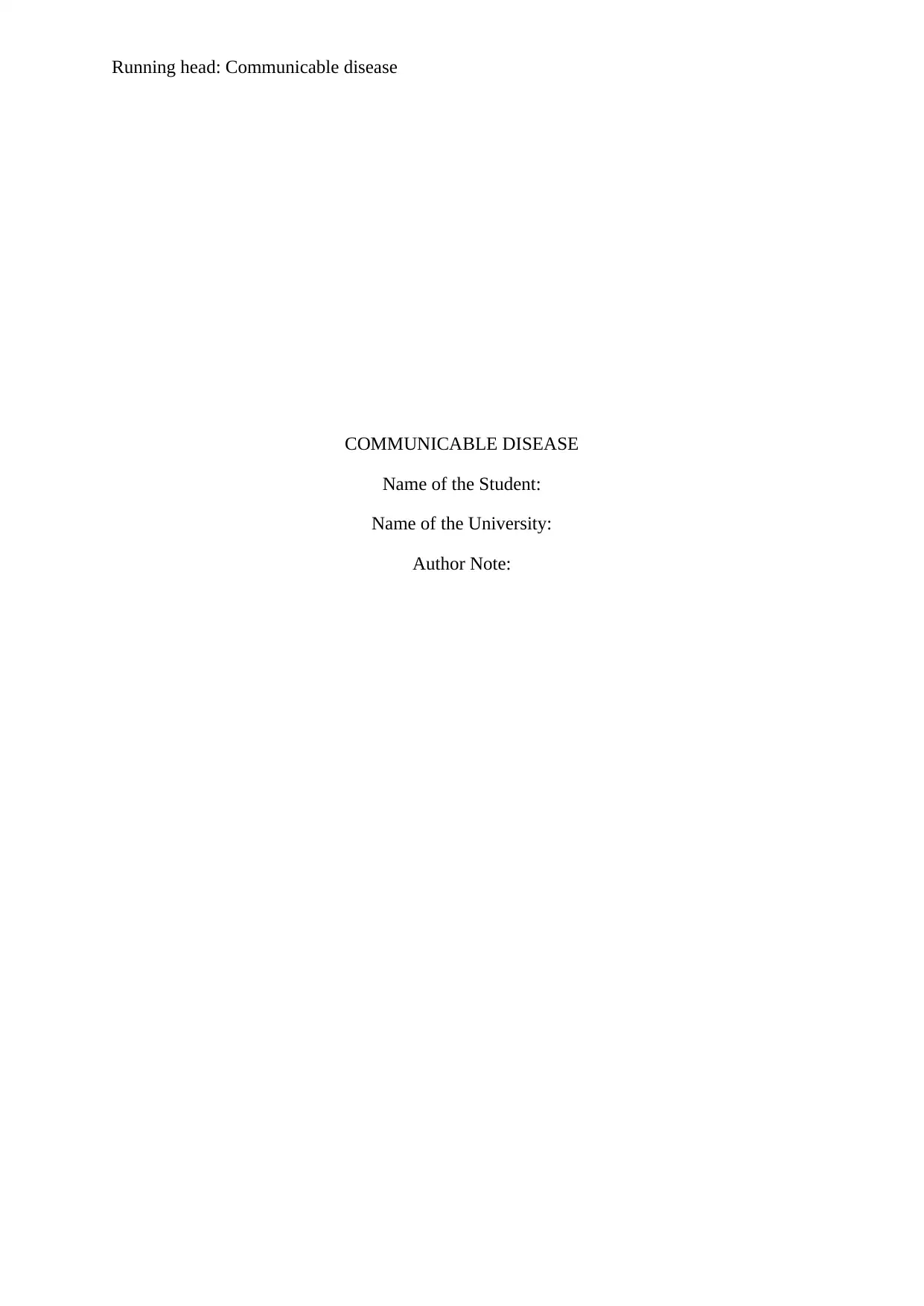
Running head: Communicable disease
COMMUNICABLE DISEASE
Name of the Student:
Name of the University:
Author Note:
COMMUNICABLE DISEASE
Name of the Student:
Name of the University:
Author Note:
Secure Best Marks with AI Grader
Need help grading? Try our AI Grader for instant feedback on your assignments.

1
Communicable disease
Table of Contents
Introduction................................................................................................................................2
Discussion..................................................................................................................................2
Hand hygiene.........................................................................................................................2
Sterilization............................................................................................................................3
Infection control.....................................................................................................................4
Immunization.........................................................................................................................5
Waste disposal........................................................................................................................5
Personal protective equipment or PPE...................................................................................6
Refernces....................................................................................................................................7
Appendix....................................................................................................................................9
Communicable disease
Table of Contents
Introduction................................................................................................................................2
Discussion..................................................................................................................................2
Hand hygiene.........................................................................................................................2
Sterilization............................................................................................................................3
Infection control.....................................................................................................................4
Immunization.........................................................................................................................5
Waste disposal........................................................................................................................5
Personal protective equipment or PPE...................................................................................6
Refernces....................................................................................................................................7
Appendix....................................................................................................................................9
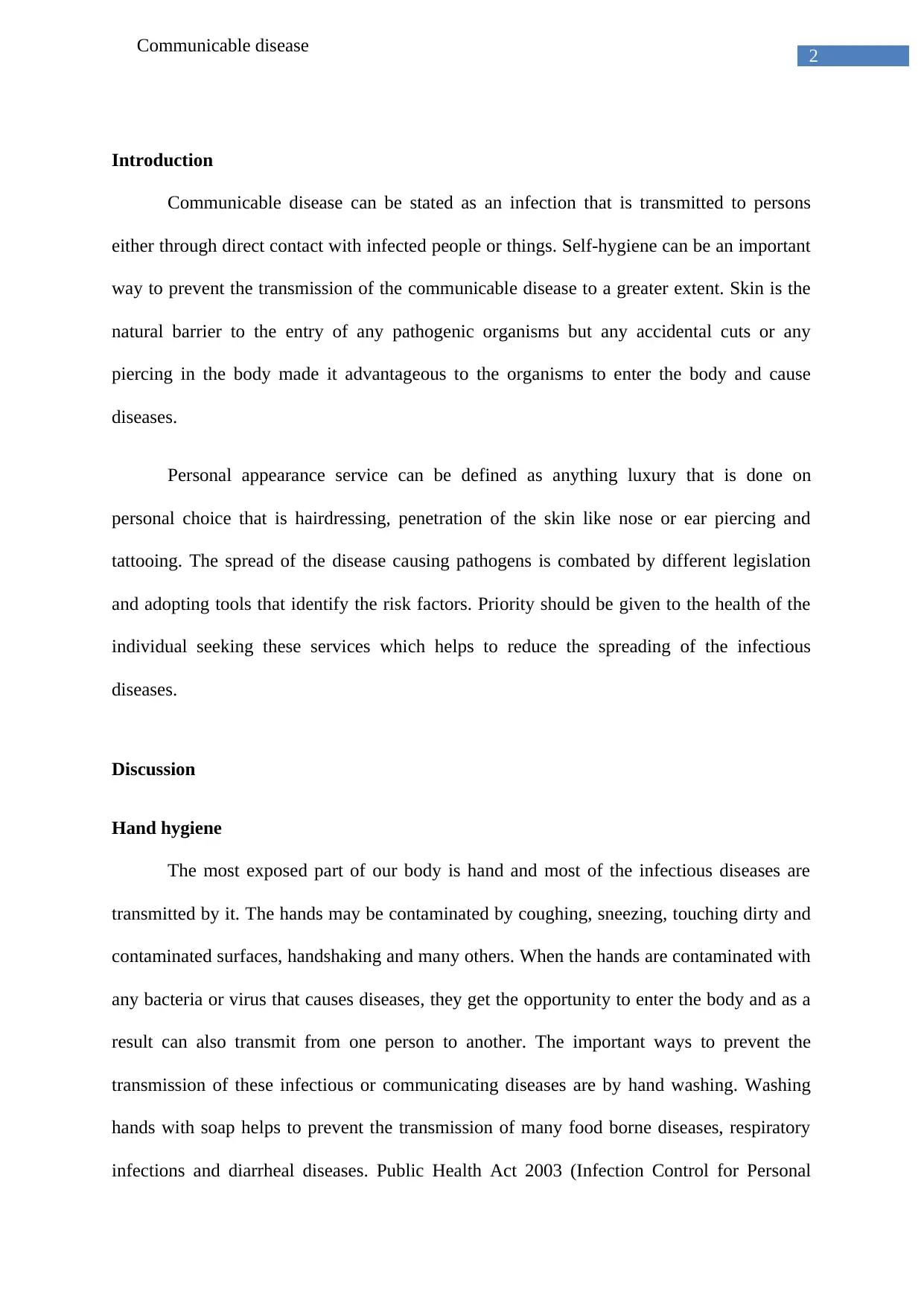
2
Communicable disease
Introduction
Communicable disease can be stated as an infection that is transmitted to persons
either through direct contact with infected people or things. Self-hygiene can be an important
way to prevent the transmission of the communicable disease to a greater extent. Skin is the
natural barrier to the entry of any pathogenic organisms but any accidental cuts or any
piercing in the body made it advantageous to the organisms to enter the body and cause
diseases.
Personal appearance service can be defined as anything luxury that is done on
personal choice that is hairdressing, penetration of the skin like nose or ear piercing and
tattooing. The spread of the disease causing pathogens is combated by different legislation
and adopting tools that identify the risk factors. Priority should be given to the health of the
individual seeking these services which helps to reduce the spreading of the infectious
diseases.
Discussion
Hand hygiene
The most exposed part of our body is hand and most of the infectious diseases are
transmitted by it. The hands may be contaminated by coughing, sneezing, touching dirty and
contaminated surfaces, handshaking and many others. When the hands are contaminated with
any bacteria or virus that causes diseases, they get the opportunity to enter the body and as a
result can also transmit from one person to another. The important ways to prevent the
transmission of these infectious or communicating diseases are by hand washing. Washing
hands with soap helps to prevent the transmission of many food borne diseases, respiratory
infections and diarrheal diseases. Public Health Act 2003 (Infection Control for Personal
Communicable disease
Introduction
Communicable disease can be stated as an infection that is transmitted to persons
either through direct contact with infected people or things. Self-hygiene can be an important
way to prevent the transmission of the communicable disease to a greater extent. Skin is the
natural barrier to the entry of any pathogenic organisms but any accidental cuts or any
piercing in the body made it advantageous to the organisms to enter the body and cause
diseases.
Personal appearance service can be defined as anything luxury that is done on
personal choice that is hairdressing, penetration of the skin like nose or ear piercing and
tattooing. The spread of the disease causing pathogens is combated by different legislation
and adopting tools that identify the risk factors. Priority should be given to the health of the
individual seeking these services which helps to reduce the spreading of the infectious
diseases.
Discussion
Hand hygiene
The most exposed part of our body is hand and most of the infectious diseases are
transmitted by it. The hands may be contaminated by coughing, sneezing, touching dirty and
contaminated surfaces, handshaking and many others. When the hands are contaminated with
any bacteria or virus that causes diseases, they get the opportunity to enter the body and as a
result can also transmit from one person to another. The important ways to prevent the
transmission of these infectious or communicating diseases are by hand washing. Washing
hands with soap helps to prevent the transmission of many food borne diseases, respiratory
infections and diarrheal diseases. Public Health Act 2003 (Infection Control for Personal
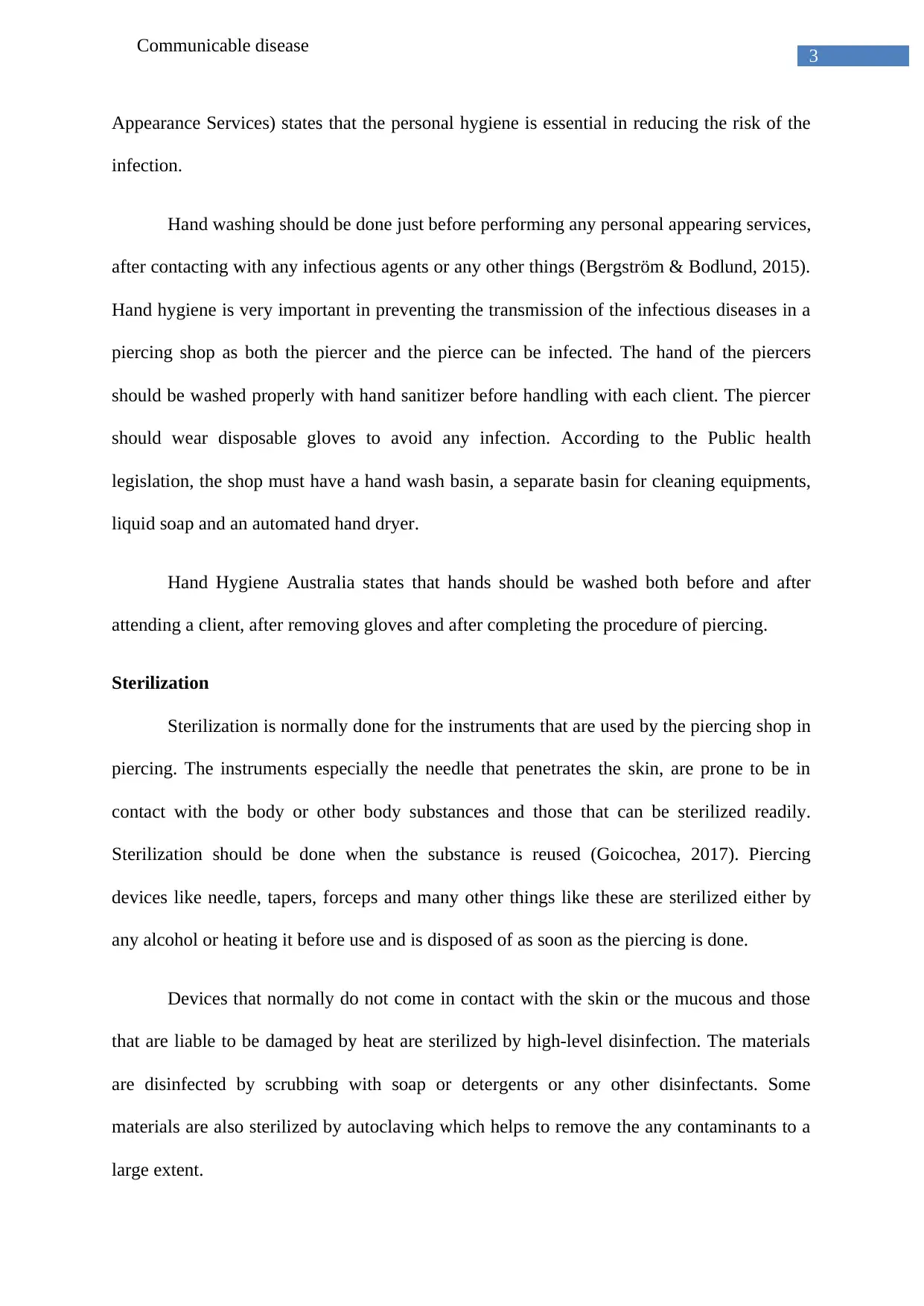
3
Communicable disease
Appearance Services) states that the personal hygiene is essential in reducing the risk of the
infection.
Hand washing should be done just before performing any personal appearing services,
after contacting with any infectious agents or any other things (Bergström & Bodlund, 2015).
Hand hygiene is very important in preventing the transmission of the infectious diseases in a
piercing shop as both the piercer and the pierce can be infected. The hand of the piercers
should be washed properly with hand sanitizer before handling with each client. The piercer
should wear disposable gloves to avoid any infection. According to the Public health
legislation, the shop must have a hand wash basin, a separate basin for cleaning equipments,
liquid soap and an automated hand dryer.
Hand Hygiene Australia states that hands should be washed both before and after
attending a client, after removing gloves and after completing the procedure of piercing.
Sterilization
Sterilization is normally done for the instruments that are used by the piercing shop in
piercing. The instruments especially the needle that penetrates the skin, are prone to be in
contact with the body or other body substances and those that can be sterilized readily.
Sterilization should be done when the substance is reused (Goicochea, 2017). Piercing
devices like needle, tapers, forceps and many other things like these are sterilized either by
any alcohol or heating it before use and is disposed of as soon as the piercing is done.
Devices that normally do not come in contact with the skin or the mucous and those
that are liable to be damaged by heat are sterilized by high-level disinfection. The materials
are disinfected by scrubbing with soap or detergents or any other disinfectants. Some
materials are also sterilized by autoclaving which helps to remove the any contaminants to a
large extent.
Communicable disease
Appearance Services) states that the personal hygiene is essential in reducing the risk of the
infection.
Hand washing should be done just before performing any personal appearing services,
after contacting with any infectious agents or any other things (Bergström & Bodlund, 2015).
Hand hygiene is very important in preventing the transmission of the infectious diseases in a
piercing shop as both the piercer and the pierce can be infected. The hand of the piercers
should be washed properly with hand sanitizer before handling with each client. The piercer
should wear disposable gloves to avoid any infection. According to the Public health
legislation, the shop must have a hand wash basin, a separate basin for cleaning equipments,
liquid soap and an automated hand dryer.
Hand Hygiene Australia states that hands should be washed both before and after
attending a client, after removing gloves and after completing the procedure of piercing.
Sterilization
Sterilization is normally done for the instruments that are used by the piercing shop in
piercing. The instruments especially the needle that penetrates the skin, are prone to be in
contact with the body or other body substances and those that can be sterilized readily.
Sterilization should be done when the substance is reused (Goicochea, 2017). Piercing
devices like needle, tapers, forceps and many other things like these are sterilized either by
any alcohol or heating it before use and is disposed of as soon as the piercing is done.
Devices that normally do not come in contact with the skin or the mucous and those
that are liable to be damaged by heat are sterilized by high-level disinfection. The materials
are disinfected by scrubbing with soap or detergents or any other disinfectants. Some
materials are also sterilized by autoclaving which helps to remove the any contaminants to a
large extent.
Secure Best Marks with AI Grader
Need help grading? Try our AI Grader for instant feedback on your assignments.
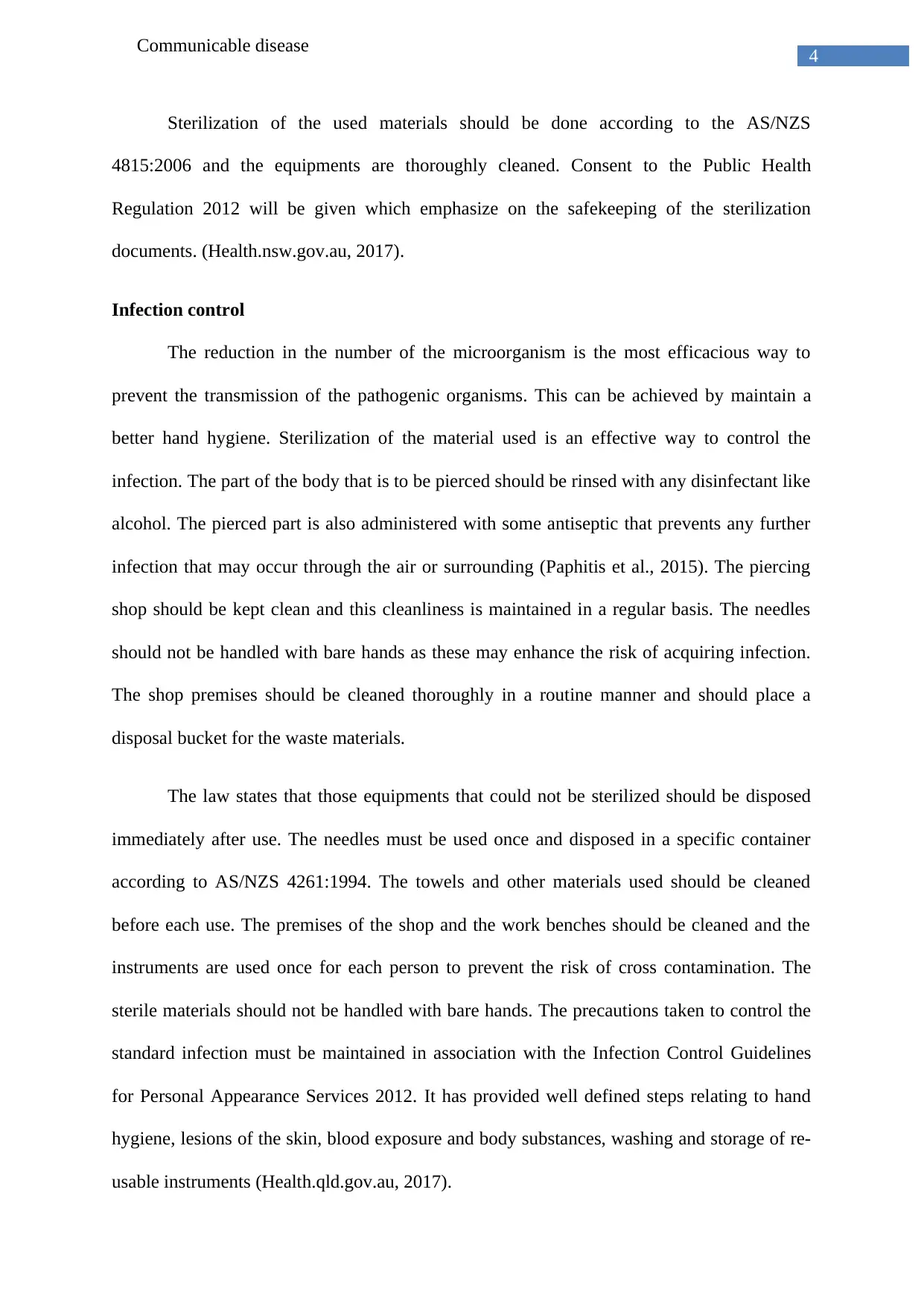
4
Communicable disease
Sterilization of the used materials should be done according to the AS/NZS
4815:2006 and the equipments are thoroughly cleaned. Consent to the Public Health
Regulation 2012 will be given which emphasize on the safekeeping of the sterilization
documents. (Health.nsw.gov.au, 2017).
Infection control
The reduction in the number of the microorganism is the most efficacious way to
prevent the transmission of the pathogenic organisms. This can be achieved by maintain a
better hand hygiene. Sterilization of the material used is an effective way to control the
infection. The part of the body that is to be pierced should be rinsed with any disinfectant like
alcohol. The pierced part is also administered with some antiseptic that prevents any further
infection that may occur through the air or surrounding (Paphitis et al., 2015). The piercing
shop should be kept clean and this cleanliness is maintained in a regular basis. The needles
should not be handled with bare hands as these may enhance the risk of acquiring infection.
The shop premises should be cleaned thoroughly in a routine manner and should place a
disposal bucket for the waste materials.
The law states that those equipments that could not be sterilized should be disposed
immediately after use. The needles must be used once and disposed in a specific container
according to AS/NZS 4261:1994. The towels and other materials used should be cleaned
before each use. The premises of the shop and the work benches should be cleaned and the
instruments are used once for each person to prevent the risk of cross contamination. The
sterile materials should not be handled with bare hands. The precautions taken to control the
standard infection must be maintained in association with the Infection Control Guidelines
for Personal Appearance Services 2012. It has provided well defined steps relating to hand
hygiene, lesions of the skin, blood exposure and body substances, washing and storage of re-
usable instruments (Health.qld.gov.au, 2017).
Communicable disease
Sterilization of the used materials should be done according to the AS/NZS
4815:2006 and the equipments are thoroughly cleaned. Consent to the Public Health
Regulation 2012 will be given which emphasize on the safekeeping of the sterilization
documents. (Health.nsw.gov.au, 2017).
Infection control
The reduction in the number of the microorganism is the most efficacious way to
prevent the transmission of the pathogenic organisms. This can be achieved by maintain a
better hand hygiene. Sterilization of the material used is an effective way to control the
infection. The part of the body that is to be pierced should be rinsed with any disinfectant like
alcohol. The pierced part is also administered with some antiseptic that prevents any further
infection that may occur through the air or surrounding (Paphitis et al., 2015). The piercing
shop should be kept clean and this cleanliness is maintained in a regular basis. The needles
should not be handled with bare hands as these may enhance the risk of acquiring infection.
The shop premises should be cleaned thoroughly in a routine manner and should place a
disposal bucket for the waste materials.
The law states that those equipments that could not be sterilized should be disposed
immediately after use. The needles must be used once and disposed in a specific container
according to AS/NZS 4261:1994. The towels and other materials used should be cleaned
before each use. The premises of the shop and the work benches should be cleaned and the
instruments are used once for each person to prevent the risk of cross contamination. The
sterile materials should not be handled with bare hands. The precautions taken to control the
standard infection must be maintained in association with the Infection Control Guidelines
for Personal Appearance Services 2012. It has provided well defined steps relating to hand
hygiene, lesions of the skin, blood exposure and body substances, washing and storage of re-
usable instruments (Health.qld.gov.au, 2017).
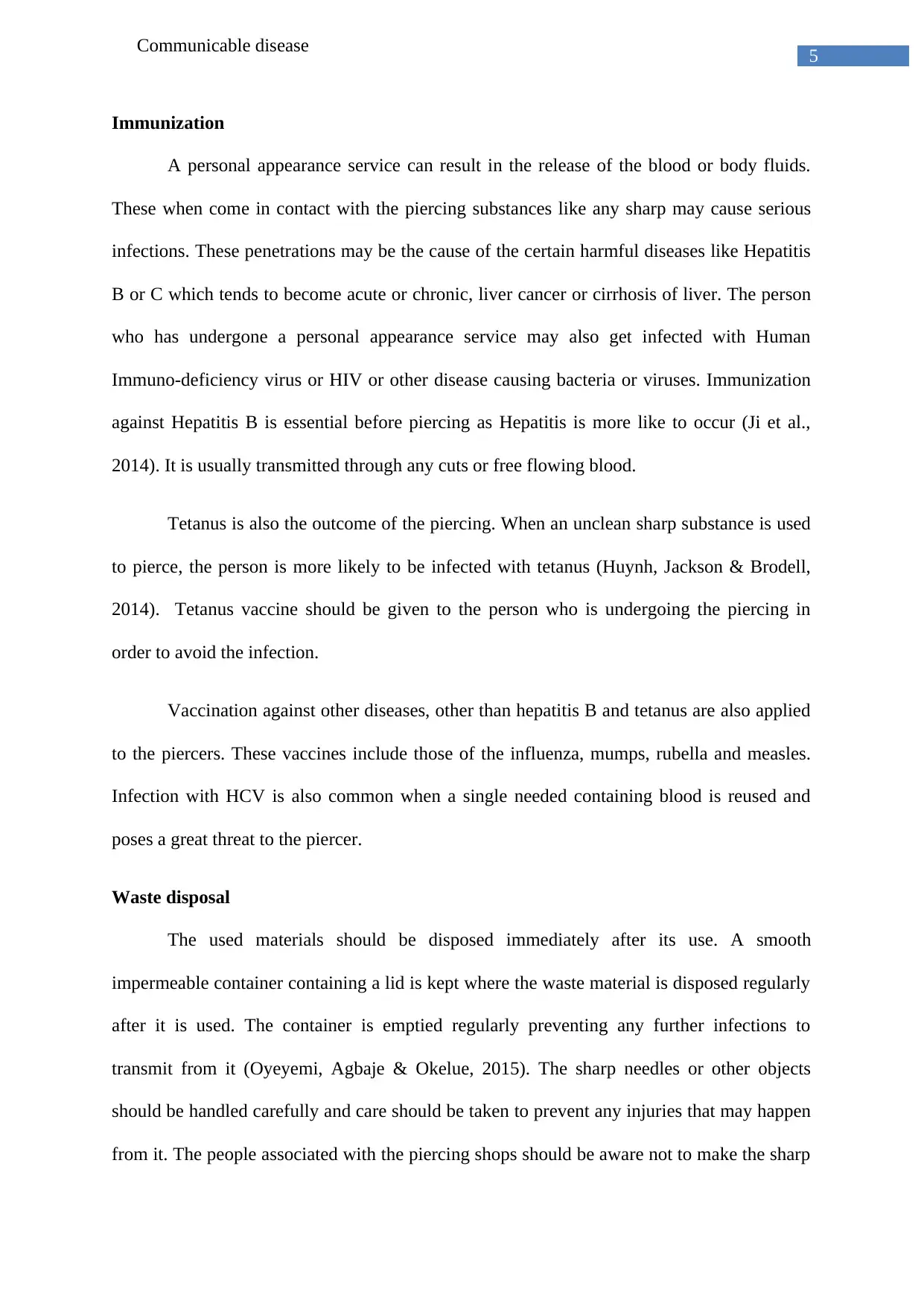
5
Communicable disease
Immunization
A personal appearance service can result in the release of the blood or body fluids.
These when come in contact with the piercing substances like any sharp may cause serious
infections. These penetrations may be the cause of the certain harmful diseases like Hepatitis
B or C which tends to become acute or chronic, liver cancer or cirrhosis of liver. The person
who has undergone a personal appearance service may also get infected with Human
Immuno-deficiency virus or HIV or other disease causing bacteria or viruses. Immunization
against Hepatitis B is essential before piercing as Hepatitis is more like to occur (Ji et al.,
2014). It is usually transmitted through any cuts or free flowing blood.
Tetanus is also the outcome of the piercing. When an unclean sharp substance is used
to pierce, the person is more likely to be infected with tetanus (Huynh, Jackson & Brodell,
2014). Tetanus vaccine should be given to the person who is undergoing the piercing in
order to avoid the infection.
Vaccination against other diseases, other than hepatitis B and tetanus are also applied
to the piercers. These vaccines include those of the influenza, mumps, rubella and measles.
Infection with HCV is also common when a single needed containing blood is reused and
poses a great threat to the piercer.
Waste disposal
The used materials should be disposed immediately after its use. A smooth
impermeable container containing a lid is kept where the waste material is disposed regularly
after it is used. The container is emptied regularly preventing any further infections to
transmit from it (Oyeyemi, Agbaje & Okelue, 2015). The sharp needles or other objects
should be handled carefully and care should be taken to prevent any injuries that may happen
from it. The people associated with the piercing shops should be aware not to make the sharp
Communicable disease
Immunization
A personal appearance service can result in the release of the blood or body fluids.
These when come in contact with the piercing substances like any sharp may cause serious
infections. These penetrations may be the cause of the certain harmful diseases like Hepatitis
B or C which tends to become acute or chronic, liver cancer or cirrhosis of liver. The person
who has undergone a personal appearance service may also get infected with Human
Immuno-deficiency virus or HIV or other disease causing bacteria or viruses. Immunization
against Hepatitis B is essential before piercing as Hepatitis is more like to occur (Ji et al.,
2014). It is usually transmitted through any cuts or free flowing blood.
Tetanus is also the outcome of the piercing. When an unclean sharp substance is used
to pierce, the person is more likely to be infected with tetanus (Huynh, Jackson & Brodell,
2014). Tetanus vaccine should be given to the person who is undergoing the piercing in
order to avoid the infection.
Vaccination against other diseases, other than hepatitis B and tetanus are also applied
to the piercers. These vaccines include those of the influenza, mumps, rubella and measles.
Infection with HCV is also common when a single needed containing blood is reused and
poses a great threat to the piercer.
Waste disposal
The used materials should be disposed immediately after its use. A smooth
impermeable container containing a lid is kept where the waste material is disposed regularly
after it is used. The container is emptied regularly preventing any further infections to
transmit from it (Oyeyemi, Agbaje & Okelue, 2015). The sharp needles or other objects
should be handled carefully and care should be taken to prevent any injuries that may happen
from it. The people associated with the piercing shops should be aware not to make the sharp

6
Communicable disease
things accessible to the visitors or clients of the shop. Clinical wastes are produced during
tattooing or body piercing where the waste contains a large amount of free flowing blood or
body fluids. A waste disposal bin should be kept in a piercing shop according to the Public
health legislation.
Personal protective equipment or PPE
Personal protective equipment or PPE is the equipments that is used for the protection
for the safety of the people against any health risk. The items that can be included in the
personal protective equipment are the helmets, gloves, protection of eyes or safety footwear
(Veenstra, 2015). The part of the skin that is used to pierce should be rinsed with germicide
to avoid any infection that is liable to occur after piercing. The piercers should wear sterilized
medical gloves after thoroughly rinsing their hands with disinfectants like soap before doing
piercing.
It is necessary for both the piercer and the pierce to wear a mask. Wearing a mask
significantly reduces the contamination that may happen from the exhalation as droplet
particles containing microorganisms are expelled out (Kasatpibal et al., 2016). The clothes
that are used as a protection from contamination should be changed daily and washed
thoroughly to avoid any contamination.
Communicable disease
things accessible to the visitors or clients of the shop. Clinical wastes are produced during
tattooing or body piercing where the waste contains a large amount of free flowing blood or
body fluids. A waste disposal bin should be kept in a piercing shop according to the Public
health legislation.
Personal protective equipment or PPE
Personal protective equipment or PPE is the equipments that is used for the protection
for the safety of the people against any health risk. The items that can be included in the
personal protective equipment are the helmets, gloves, protection of eyes or safety footwear
(Veenstra, 2015). The part of the skin that is used to pierce should be rinsed with germicide
to avoid any infection that is liable to occur after piercing. The piercers should wear sterilized
medical gloves after thoroughly rinsing their hands with disinfectants like soap before doing
piercing.
It is necessary for both the piercer and the pierce to wear a mask. Wearing a mask
significantly reduces the contamination that may happen from the exhalation as droplet
particles containing microorganisms are expelled out (Kasatpibal et al., 2016). The clothes
that are used as a protection from contamination should be changed daily and washed
thoroughly to avoid any contamination.
Paraphrase This Document
Need a fresh take? Get an instant paraphrase of this document with our AI Paraphraser
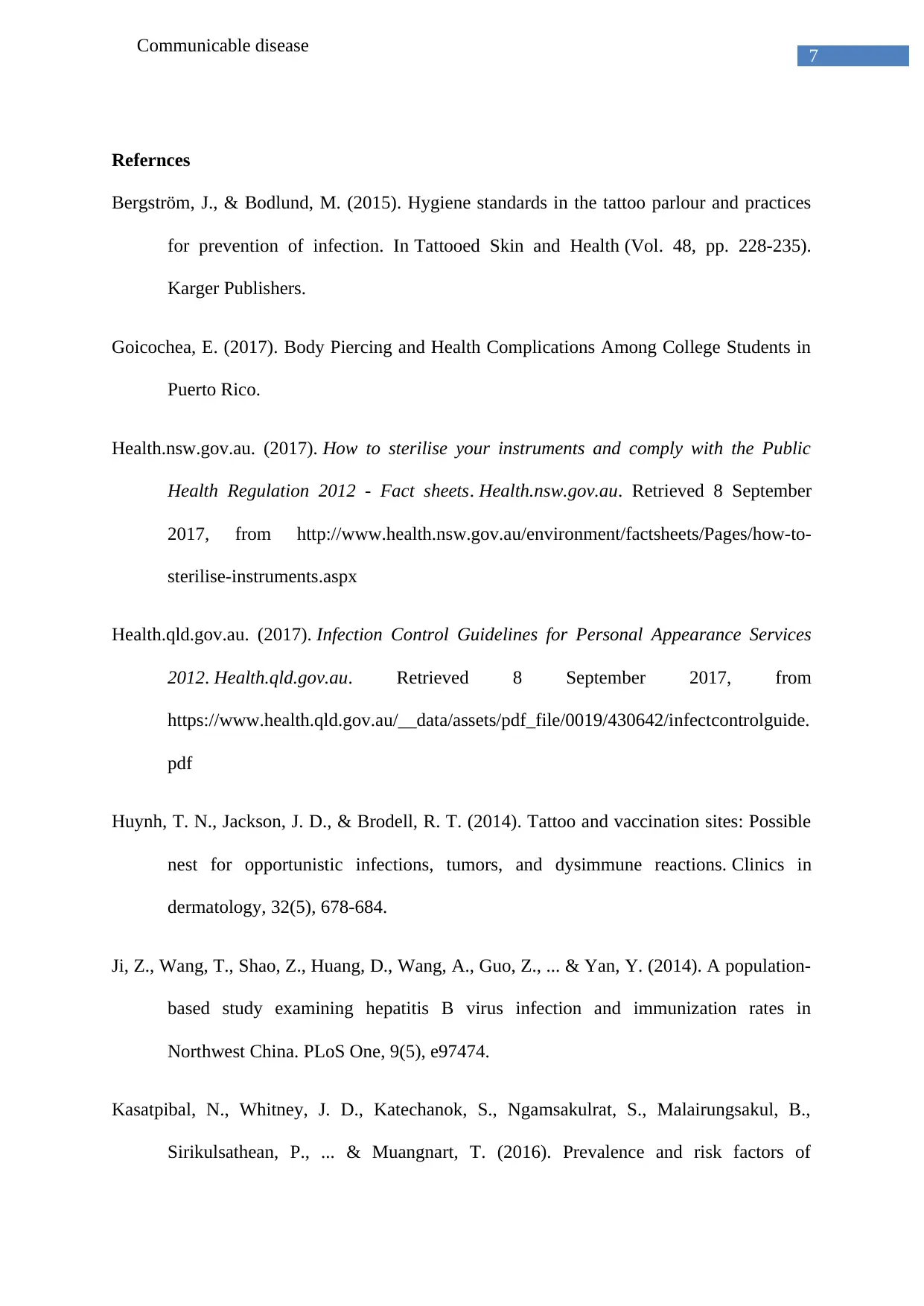
7
Communicable disease
Refernces
Bergström, J., & Bodlund, M. (2015). Hygiene standards in the tattoo parlour and practices
for prevention of infection. In Tattooed Skin and Health (Vol. 48, pp. 228-235).
Karger Publishers.
Goicochea, E. (2017). Body Piercing and Health Complications Among College Students in
Puerto Rico.
Health.nsw.gov.au. (2017). How to sterilise your instruments and comply with the Public
Health Regulation 2012 - Fact sheets. Health.nsw.gov.au. Retrieved 8 September
2017, from http://www.health.nsw.gov.au/environment/factsheets/Pages/how-to-
sterilise-instruments.aspx
Health.qld.gov.au. (2017). Infection Control Guidelines for Personal Appearance Services
2012. Health.qld.gov.au. Retrieved 8 September 2017, from
https://www.health.qld.gov.au/__data/assets/pdf_file/0019/430642/infectcontrolguide.
pdf
Huynh, T. N., Jackson, J. D., & Brodell, R. T. (2014). Tattoo and vaccination sites: Possible
nest for opportunistic infections, tumors, and dysimmune reactions. Clinics in
dermatology, 32(5), 678-684.
Ji, Z., Wang, T., Shao, Z., Huang, D., Wang, A., Guo, Z., ... & Yan, Y. (2014). A population-
based study examining hepatitis B virus infection and immunization rates in
Northwest China. PLoS One, 9(5), e97474.
Kasatpibal, N., Whitney, J. D., Katechanok, S., Ngamsakulrat, S., Malairungsakul, B.,
Sirikulsathean, P., ... & Muangnart, T. (2016). Prevalence and risk factors of
Communicable disease
Refernces
Bergström, J., & Bodlund, M. (2015). Hygiene standards in the tattoo parlour and practices
for prevention of infection. In Tattooed Skin and Health (Vol. 48, pp. 228-235).
Karger Publishers.
Goicochea, E. (2017). Body Piercing and Health Complications Among College Students in
Puerto Rico.
Health.nsw.gov.au. (2017). How to sterilise your instruments and comply with the Public
Health Regulation 2012 - Fact sheets. Health.nsw.gov.au. Retrieved 8 September
2017, from http://www.health.nsw.gov.au/environment/factsheets/Pages/how-to-
sterilise-instruments.aspx
Health.qld.gov.au. (2017). Infection Control Guidelines for Personal Appearance Services
2012. Health.qld.gov.au. Retrieved 8 September 2017, from
https://www.health.qld.gov.au/__data/assets/pdf_file/0019/430642/infectcontrolguide.
Huynh, T. N., Jackson, J. D., & Brodell, R. T. (2014). Tattoo and vaccination sites: Possible
nest for opportunistic infections, tumors, and dysimmune reactions. Clinics in
dermatology, 32(5), 678-684.
Ji, Z., Wang, T., Shao, Z., Huang, D., Wang, A., Guo, Z., ... & Yan, Y. (2014). A population-
based study examining hepatitis B virus infection and immunization rates in
Northwest China. PLoS One, 9(5), e97474.
Kasatpibal, N., Whitney, J. D., Katechanok, S., Ngamsakulrat, S., Malairungsakul, B.,
Sirikulsathean, P., ... & Muangnart, T. (2016). Prevalence and risk factors of
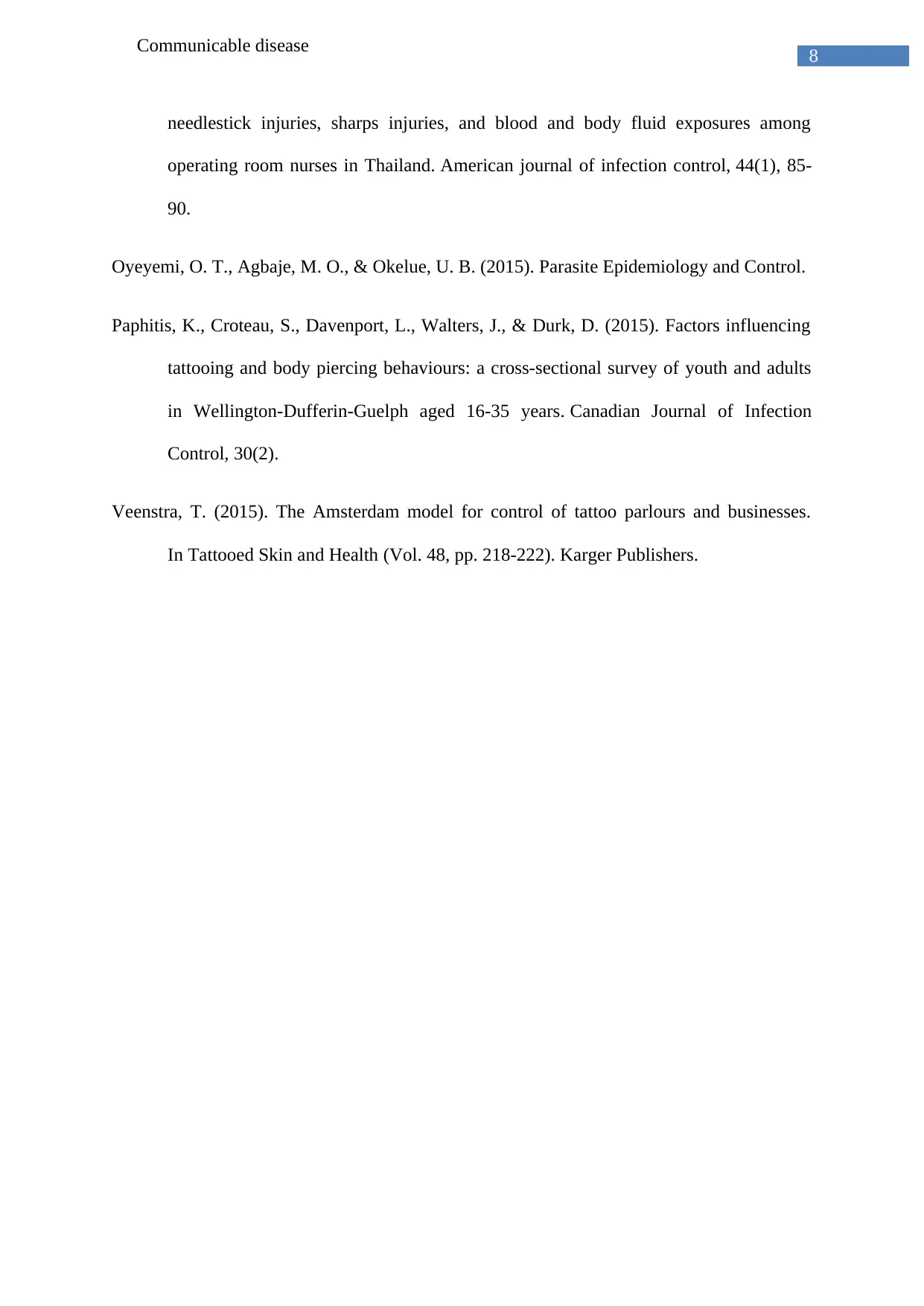
8
Communicable disease
needlestick injuries, sharps injuries, and blood and body fluid exposures among
operating room nurses in Thailand. American journal of infection control, 44(1), 85-
90.
Oyeyemi, O. T., Agbaje, M. O., & Okelue, U. B. (2015). Parasite Epidemiology and Control.
Paphitis, K., Croteau, S., Davenport, L., Walters, J., & Durk, D. (2015). Factors influencing
tattooing and body piercing behaviours: a cross-sectional survey of youth and adults
in Wellington-Dufferin-Guelph aged 16-35 years. Canadian Journal of Infection
Control, 30(2).
Veenstra, T. (2015). The Amsterdam model for control of tattoo parlours and businesses.
In Tattooed Skin and Health (Vol. 48, pp. 218-222). Karger Publishers.
Communicable disease
needlestick injuries, sharps injuries, and blood and body fluid exposures among
operating room nurses in Thailand. American journal of infection control, 44(1), 85-
90.
Oyeyemi, O. T., Agbaje, M. O., & Okelue, U. B. (2015). Parasite Epidemiology and Control.
Paphitis, K., Croteau, S., Davenport, L., Walters, J., & Durk, D. (2015). Factors influencing
tattooing and body piercing behaviours: a cross-sectional survey of youth and adults
in Wellington-Dufferin-Guelph aged 16-35 years. Canadian Journal of Infection
Control, 30(2).
Veenstra, T. (2015). The Amsterdam model for control of tattoo parlours and businesses.
In Tattooed Skin and Health (Vol. 48, pp. 218-222). Karger Publishers.
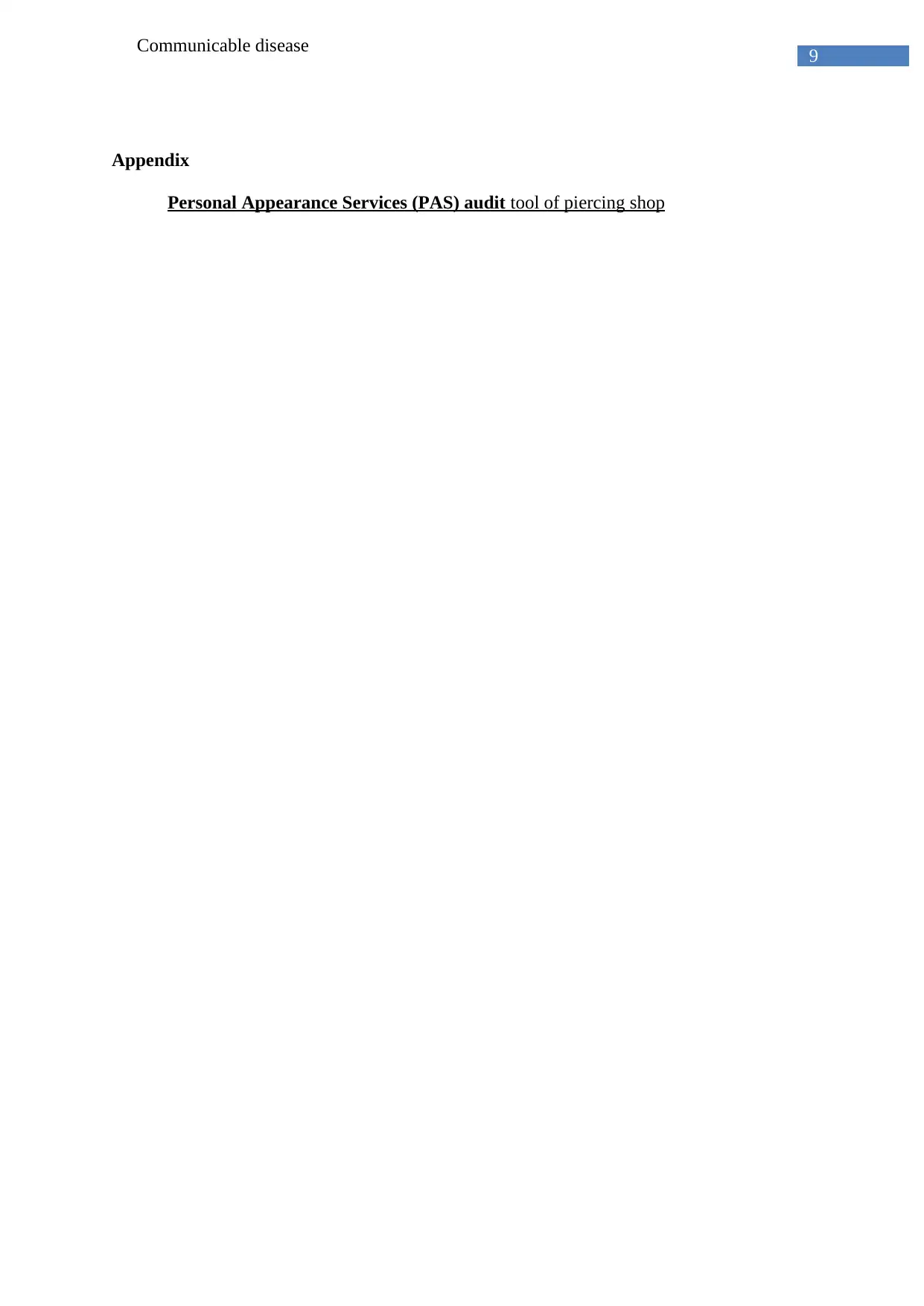
9
Communicable disease
Appendix
Personal Appearance Services (PAS) audit tool of piercing shop
Communicable disease
Appendix
Personal Appearance Services (PAS) audit tool of piercing shop
1 out of 10
Related Documents
Your All-in-One AI-Powered Toolkit for Academic Success.
+13062052269
info@desklib.com
Available 24*7 on WhatsApp / Email
![[object Object]](/_next/static/media/star-bottom.7253800d.svg)
Unlock your academic potential
© 2024 | Zucol Services PVT LTD | All rights reserved.





